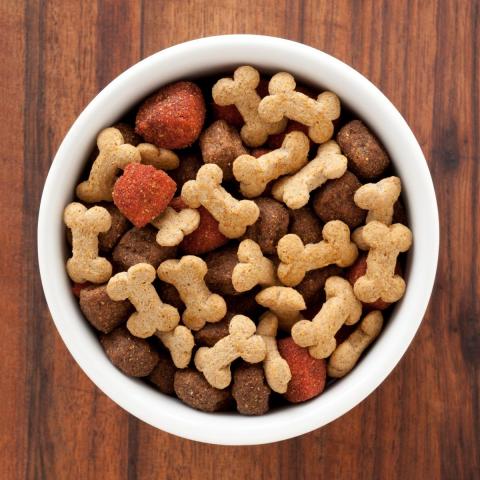Feeding our Pets: Facts You Can Use When Considering GMO Ingredients

By Cathleen Enright, PhD, President & CEO, Pet Food Institute
Diet and nutrition are two very important factors in our lives, and the same can be said for our pets. As questions arise about both human and animal food products containing ingredients derived from GMO crops, it is easy to become misinformed. Understanding the science behind how our food is produced and making informed food choices is just as important for feeding our families as feeding our four-legged friends. In light of “National Love Your Pet Day,” GMO Answers asked President and CEO of Pet Food Institute Cathleen Enright, PhD for her take on GMOs and pet food.
Pets are an important part of family for nearly two-thirds of U.S. households—that’s approximately 180 million cats and dogs. We celebrate our pets’ birthdays, give them presents on holidays and are increasingly recognizing the impact of the human-animal bond. An emerging body of evidence suggests we are better off mentally and physically when we share our lives with a pet. Lower blood pressure, reduced stress levels, improved scholastic performance, enhanced social interactions and increased activity are among the many benefits documented.
As we appreciate pets for their support of our health and happiness, we are becoming more interested in their wellbeing, particularly in their diets and nutrition. At the Pet Food Institute (PFI), the voice of U.S. dog and cat food makers, we provide factual information about these and other issues, including safety, to pet lovers. We also advocate for a transparent, science-based regulatory environment for our members, who produce 98 percent of U.S. pet food and treats.
Similar to trends in human food, pet lovers are researching topics such as how pet food is made, where the ingredients come from, and what’s in a label. Pet food shoppers also have questions about the use and safety of GMOs in pet food products.
Nutrition from Nose to Tail

For the vast majority of dogs and cats in the America, pet food serves as their sole source of nutrition and PFI members take seriously their responsibility in this regard. Most pet food recipes are designed to be “complete and balanced,” meaning that they provide the more than 40 essential nutrients at the proper levels that dogs and cats require for their species and life stage—vitamins, minerals, essential fatty acids, protein and individual amino acids. These nutrients are provided by the ingredients in a pet food recipe, and not just any ingredient will do.
An ingredient cannot be used in pet food until it has been accepted by the FDA and adopted by the Association of American Feed Officials (AAFCO), the organization of state regulatory officials that develops state model bills and regulations for pet food. Most people aren’t aware that in the United States, pet food is one of most regulated foods in America, and must meet federal and state requirements.
When selecting an ingredient for a dog or cat food recipe, pet food makers consider multiple factors, such as safety, nutrient content, tastiness to pets, ability to help the food hold shape, availability and cost.
What About GMO Ingredients?
Because plant-based pet food ingredients are produced during the processing of human food, it shouldn’t surprise anyone to learn that pet foods contain GMO ingredients. Of course, the safety debate over GMOs is over. The overwhelming preponderance of evidence demonstrated that GMOs are as safe for animals as non-GMOs and deliver the same nutrition.
In fact, a 2014 analysis of existing data covering more than 20 years found that animals provided food with GMO ingredients had no adverse health impact in comparison to food without GMO ingredients. Additionally, a review of more than 100 studies on animal feed found agreement that GMOs did not impact the digestibility of the food, and therefore, the bio-availability of the nutrients provided.

Informed Pet Food Shopping
At the end of the day, pet food makers want pet lovers to enjoy feeding their cat or dog. When choosing a pet food or treat, we recommend looking for a recipe that is complete and balanced for the pet’s appropriate life stage. This information can be found in the “Nutritional Adequacy Statement” on a pet food label. From there, pet parents have an array of options to choose from that provide proper nutrition and meet a family’s preferences and needs. If your preference is non-GMO pet food, our members make this too, just look for labels with “organic” or “non-GMO” claims.
For more information about pet food safety and nutrition, please visit www.petfoodinstitute.org.
This post was originally published on GMO Answers' Medium page.